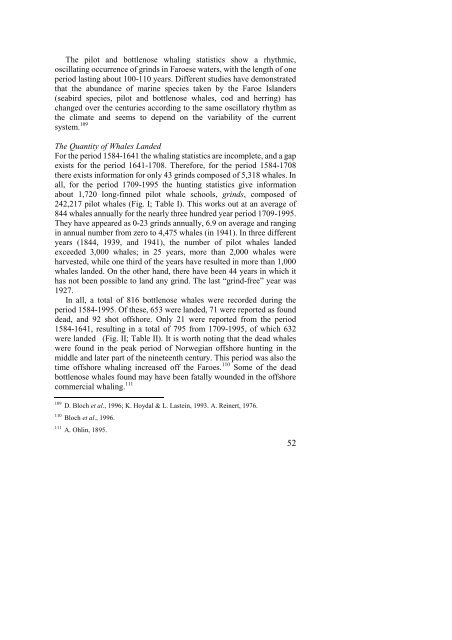The North Atlantic Fisheries, 1100-1976 - University of Hull
The North Atlantic Fisheries, 1100-1976 - University of Hull
The North Atlantic Fisheries, 1100-1976 - University of Hull
Create successful ePaper yourself
Turn your PDF publications into a flip-book with our unique Google optimized e-Paper software.
<strong>The</strong> pilot and bottlenose whaling statistics show a rhythmic,<br />
oscillating occurrence <strong>of</strong> grinds in Faroese waters, with the length <strong>of</strong> one<br />
period lasting about 100-110 years. Different studies have demonstrated<br />
that the abundance <strong>of</strong> marine species taken by the Faroe Islanders<br />
(seabird species, pilot and bottlenose whales, cod and herring) has<br />
changed over the centuries according to the same oscillatory rhythm as<br />
the climate and seems to depend on the variability <strong>of</strong> the current<br />
system. 109<br />
<strong>The</strong> Quantity <strong>of</strong> Whales Landed<br />
For the period 1584-1641 the whaling statistics are incomplete, and a gap<br />
exists for the period 1641-1708. <strong>The</strong>refore, for the period 1584-1708<br />
there exists information for only 43 grinds composed <strong>of</strong> 5,318 whales. In<br />
all, for the period 1709-1995 the hunting statistics give information<br />
about 1,720 long-finned pilot whale schools, grinds, composed <strong>of</strong><br />
242,217 pilot whales (Fig. I; Table I). This works out at an average <strong>of</strong><br />
844 whales annually for the nearly three hundred year period 1709-1995.<br />
<strong>The</strong>y have appeared as 0-23 grinds annually, 6.9 on average and ranging<br />
in annual number from zero to 4,475 whales (in 1941). In three different<br />
years (1844, 1939, and 1941), the number <strong>of</strong> pilot whales landed<br />
exceeded 3,000 whales; in 25 years, more than 2,000 whales were<br />
harvested, while one third <strong>of</strong> the years have resulted in more than 1,000<br />
whales landed. On the other hand, there have been 44 years in which it<br />
has not been possible to land any grind. <strong>The</strong> last “grind-free” year was<br />
1927.<br />
In all, a total <strong>of</strong> 816 bottlenose whales were recorded during the<br />
period 1584-1995. Of these, 653 were landed, 71 were reported as found<br />
dead, and 92 shot <strong>of</strong>fshore. Only 21 were reported from the period<br />
1584-1641, resulting in a total <strong>of</strong> 795 from 1709-1995, <strong>of</strong> which 632<br />
were landed (Fig. II; Table II). It is worth noting that the dead whales<br />
were found in the peak period <strong>of</strong> Norwegian <strong>of</strong>fshore hunting in the<br />
middle and later part <strong>of</strong> the nineteenth century. This period was also the<br />
time <strong>of</strong>fshore whaling increased <strong>of</strong>f the Faroes. 110 Some <strong>of</strong> the dead<br />
bottlenose whales found may have been fatally wounded in the <strong>of</strong>fshore<br />
commercial whaling. 111<br />
109 D. Bloch et al., 1996; K. Hoydal & L. Lastein, 1993. A. Reinert, <strong>1976</strong>.<br />
110 Bloch et al., 1996.<br />
111 A. Ohlin, 1895.<br />
52















